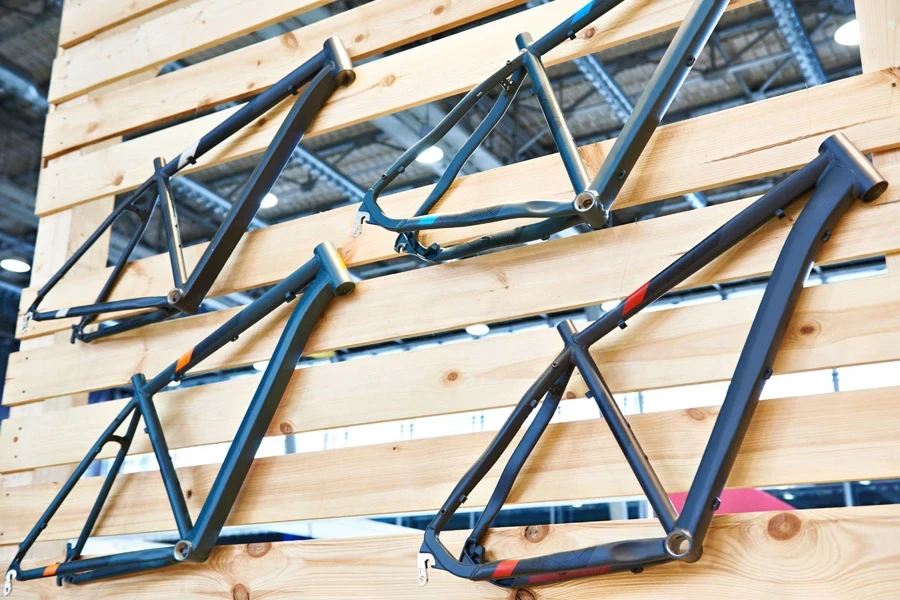Table of Contents
● Introduction
● Bicycle Frames’ Market Overview
● Key Considerations of Selection
● Conclusion
Introduction
The core of any bicycle is its frame, the backbone that defines the ride’s quality, durability, and comfort. With the cycling industry rapidly advancing, selecting the right bicycle frame is more complex than ever. This guide is crafted to assist business professionals and online retailers in making informed decisions, ensuring their customers find the perfect match for their cycling aspirations.
Bicycle Frames’ Market Overview
The bicycle frame market is a dynamic segment within the cycling industry, reflecting a blend of technological innovation and consumer demand. There are 49500 Google search results on bicycle frames. As of recent years, the market has been expanding, with a projected CAGR of approximately 6% from 2023 to 2029. The competition is intense, with brands like Giant, Trek, and Specialized leading the market share, offering frames that cater to a wide array of cycling disciplines and preferences.

Key Considerations of Selection
Material Matters
Aluminum: The Go-To for Lightweight Affordability
Aluminum frames stand out for their exceptional balance between weight and performance, making them a favored choice among cyclists looking for both efficiency and cost-effectiveness. With a modulus of 10 to 11 x 10^6 psi and a relatively low density of 168.5 lb/ft^3, aluminum offers a frame that is significantly lighter than steel, without compromising on strength. The material’s yield strength ranges from 11 to 59 x 10^3 psi, depending on the alloy and treatment, allowing for the construction of frames that are both resilient and responsive. Aluminum’s inherent qualities make it possible to design frames with larger tube diameters and thinner walls, achieving the desired stiffness and ride quality without a hefty weight penalty.
Carbon Fiber: The Pinnacle of Performance
Carbon fiber is renowned for its unparalleled combination of lightness and stiffness, providing cyclists with frames that are both incredibly lightweight and exceptionally stiff. This material’s unique properties stem from its fibrous composition, allowing for targeted strength along specific load paths. Carbon frames can be engineered with varying stiffness and compliance in different areas, catering to the most demanding performance criteria. However, this advanced material comes at a premium, reflecting the complex manufacturing processes and the high level of engineering required to produce frames that push the boundaries of cycling technology.
Steel: The Classic Choice for Durability and Comfort
Steel’s reputation for durability and a smooth ride is well-earned, with a modulus of 30 x 10^6 psi and a high density of 490 lb/ft^3. This material’s strength, characterized by a yield point ranging from 46 to 162 x 10^3 psi, makes it incredibly resilient, capable of withstanding the rigors of extensive use. The ride quality of steel frames is often described as “lively” or “springy,” offering a level of comfort and shock absorption that is distinct from other materials. While steel frames tend to be heavier, their unmatched durability and the nuanced ride feel make them a cherished option among enthusiasts and custom builders.

Titanium: The Exquisite Blend of Strength and Lightness
Titanium frames are revered for their exceptional blend of lightness, strength, and corrosion resistance, offering a ride quality that is both refined and robust. With a modulus of 15 to 16.5 x 10^6 psi and a density of 280 lb/ft^3, titanium strikes an exquisite balance between the rigidity needed for efficient power transfer and the compliance desired for comfort. Its yield strength, ranging from 40 to 120 x 10^3 psi, ensures that titanium frames can endure the demands of aggressive riding and harsh conditions without succumbing to fatigue or corrosion. This combination of attributes makes titanium the material of choice for discerning cyclists seeking a frame that offers a lifetime of reliable and enjoyable riding experiences.
Geometry and Sizing
Race vs. Comfort Geometry: Enhancing the Ride
Frame geometry significantly impacts a bike’s handling, affecting agility and comfort. Race geometries are aggressive with steeper angles and shorter wheelbases for quick maneuvers and speed, ideal for competitive cycling. Comfort geometries feature slacker angles and longer wheelbases for stability and smoother rides over long distances, minimizing fatigue.
Custom Sizing: Tailored for Excellence
Custom-sized frames offer a personalized fit, aligning with the rider’s specific dimensions and style. This tailored approach optimizes comfort, efficiency, and power, making the bike feel like an extension of the rider. Although custom frames require a greater investment, they deliver unmatched performance and comfort, often involving professional fittings to achieve the perfect geometry.
Frame Features
Mounting Options: Ready for Any Adventure
Modern bicycle frames often come equipped with a variety of mounting options to cater to the diverse needs of riders. These include threaded mounts for racks and fenders, which are indispensable for touring and commuting cyclists who require additional cargo capacity and protection from road spray. Additionally, multiple water bottle cage mounts are increasingly common, not only on the down tube and seat tube but also on the underside of the down tube and on the fork legs. This adaptability allows riders to tailor their bikes for long-distance rides, bikepacking adventures, or daily commutes, ensuring that essential gear and hydration are always within reach.

Cable Routing: Sleek Design Meets Aerodynamic Efficiency
Internal cable routing has become a hallmark of modern frame design, offering a sleek, uncluttered aesthetic that complements the clean lines of contemporary bicycles. Beyond aesthetics, internal routing also provides aerodynamic benefits by minimizing air resistance, a feature particularly valued in road racing and time trial contexts. However, this design choice can introduce complexity to maintenance and repair tasks, as accessing cables housed within the frame requires additional disassembly. Despite this, many riders and mechanics appreciate the trade-off for the visual appeal and marginal aerodynamic gains internal routing provides.
Bottom Bracket Standards: Compatibility and Performance Considerations
The cycling industry has seen a proliferation of bottom bracket standards in recent years, each with its own set of advantages and compatibility considerations. From traditional threaded bottom brackets known for their reliability and ease of maintenance to press-fit standards that offer weight savings and increased stiffness, the choice of bottom bracket can significantly influence a frame’s performance characteristics and compatibility with various cranksets. Riders and builders must carefully consider the intended use, compatibility with existing components, and personal preferences when selecting a frame, as the bottom bracket standard can impact the overall ride experience and ease of maintenance.
Aesthetics
Design: Crafting Identity and Appeal
Bicycle frame design significantly influences a rider’s connection to their bike, incorporating shape, color, and graphics to reflect personal style and cycling culture. Designers aim to appeal to diverse tastes with a range of colors and styles, from bold and vibrant to classic and subtle. The design process taps into current trends across fashion and sports, ensuring frames are both contemporary and timeless.

Finish: Durability Meets Aesthetics
The finish of a bicycle frame is crucial for both aesthetics and durability. Modern painting and coating methods not only create eye-catching effects but also shield the frame from damage and corrosion. Details like paint, decals, and clear coats are carefully applied for lasting beauty and protection, making the bike a durable and attractive companion.
Conclusion
The right bicycle frame is a gateway to an enhanced cycling experience. By considering the market trends and detailed selection criteria, professionals can guide their customers to the ideal frame choice for 2024. Remember, the best frame is one that aligns with the rider’s goals, fits well, and provides the desired balance of performance and price.



